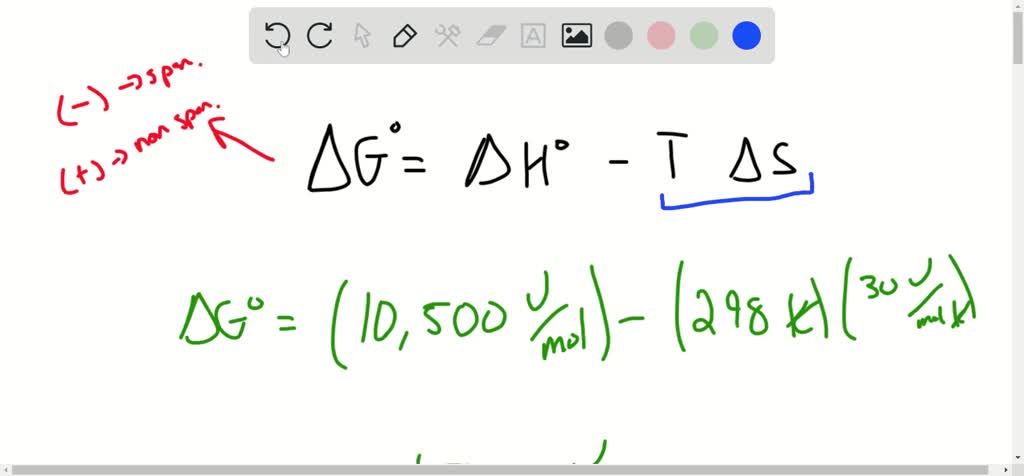

Thus although the free energy always falls when a gas expands or a chemical reaction takes place spontaneously, there need be no compensating increase in energy anywhere else. For elements it's always zero, even the o2 or the diatomics. It actually is a process going from its elements reforming that. T is temperature (SI unit: kelvin) S is entropy (SI unit: joule/kelvin) H is the enthalpy (SI unit: joule) Gibbs Energy in Reactions Spontaneous - is a reaction that is consider to be natural because it is a reaction that occurs by itself without any external action towards it. For compounds, when we're talking of the delta H, it's a formation of that. Free Energy is not energy: A much more serious difficulty with the Gibbs function, particularly in the context of chemistry, is that although G has the units of energy (joules, or in its intensive form, J mol –1), it lacks one of the most important attributes of energy in that it is not conserved. So if we have an element, elements have a delta H of zero, always.What is the difference between Delta G and Delta S Delta S, the. This is most commonly in the form of electrical work (moving electric charge through a potential difference), but other forms of work (osmotic work, increase in surface area) are also possible. The chemical equation is: 2 NO 2 (g) -> N 2 O 4 (g) For this reaction, E is -54.72 kJ. The equation for delta S is Delta S Q/T, where Q is the heat transferred to the system and T is the temperature. Chemistry Chemistry questions and answers A) For the reaction 4HCl (g) + O2 (g)->2H2O (g) + 2Cl2 (g) Delta H -114.4 kJ and Delta S -128.9 J/K The equilibrium constant for this reaction at 306. By "useful", we mean work other than that which is associated with the expansion of the system. Study with Quizlet and memorize flashcards containing terms like Predict the signs of delta S and delta H for the freezing of water into ice at 273 degrees, Predict the sign of delta S and delta H for the combustion of gasoline at 500 K, Predict the sign of delta S and delta H for the evaporation of water from a glass and more. Calculate Delta H, Delta G, and Delta S for this reaction at 2000 degree C using the temperature. Consider the reaction: CH4 (g) + 2 O2 (g) rightarrow CO2 (g) + 2 H2O (g). Delta S refers to a change in entropy and this delta S will be strongl. The “free” part of the older name reflects the steam-engine origins of thermodynamics with its interest in converting heat into work: ΔG is the maximum amount of energy which can be “freed” from the system to perform useful work. The reaction is methane + oxygen yielding water. Free Energy is not necessarily "free": The appellation “free energy” for G has led to so much confusion that many scientists now refer to it simply as the Gibbs energy. When the heat is supplied, the enthalpy of the reaction is positive and hence, the reaction is endothermic but when the heat is released, the enthalpy of the reaction is negative and hence, the.


There's probably a mathematical correlation, but qualitatively, a positive deltaH usually means a positive deltaS, and same for negative. Why: the sign flips when you flip the equation, and the enthalpy number drops by 0.5 when you scale the reaction by 0.5. C2H2(g) + O2(g) arrow 2CO2(g) + H2O(l) Delta H -1299. Delta S is the measure of entropy/the number of positions, and that usually increases when going from solid->liquid->gas, all of which happen with heat added. Turn around your second input equation, and multiply it throughout by the factor (1/2): (2SO3 2SO2 + O2)0.5 -> SO3 SO2 + (1/2)O2 associated with delta H (+198.2)0.5. delta H H (product) - H reactant +ve value. (endothermic) Hence H (product) > H reactant. Reaction is decomposition reaction and needs energy to break H2O. S (product) > S (reactant) deta S S (product) - S (reactant) +ve. It means randomness is increasing from reactant to product. Quantity Value Units Method Reference Comment r H-13.9 4.0: kJ/mol: RSC: Landrum and Hoff, 1985: The reaction enthalpy was obtained from the value for the reaction 2Cr(Cp)(CO)3(H)(cr) + 1,3-cy-C6H8(solution) Cr(Cp)(CO)32(cr) + cy-C6H10(solution), -98.3 3.8 kJ/mol Landrum and Hoff, 1985, together with the calculated enthalpy for 1,3-cy-C6H8(l) + H2(g) cy-C6H10(l), -112.21.3. For example, our desired reaction has C 2H 4 as a reactant, and only one reaction from our data has C 2H 4.\) Calculate Delta H for the reaction 2C(s) + H2(g) arrow C2H2(g) using the following equations. reactant has only 2 moles and products have three moles. We will start by writing chemical reactions that put the correct number of moles of the correct substance on the proper side.


 0 kommentar(er)
0 kommentar(er)
